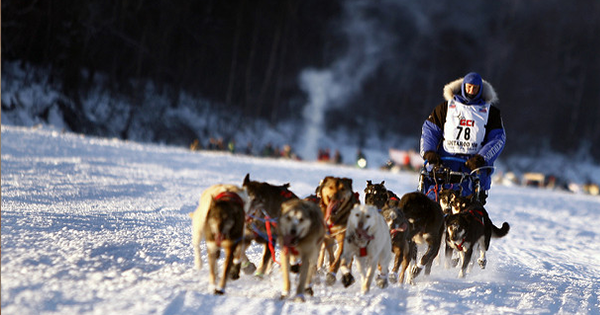
Seven or eight years ago, the last time I went to the ceremonial start of the Iditarod in downtown Anchorage, it was so frigid that I had to duck into a nearby army surplus store to buy heavy-duty mittens to replace the lightweight gloves I had on. The temperature last Saturday for the start of this year’s race, which attracts thousands of tourists from all over the world, was a balmy 30 degrees before the sun broke out around noon and it got even warmer.
The Alaska Railroad hauled seven train cars full of snow from Fairbanks to spread along the otherwise snowless ceremonial route. But it turns out that Anchorage officials didn’t use it, saying the white stuff contained rocks and other debris. They tapped a local snow dump instead. Oh, the politics of snow in a winter of scarcity! The race officially began last Sunday, the day after the public festivities, about 35 miles north of Anchorage in Willow.
Since I don’t know much about the race beyond what I read in the newspaper, I called a friend of a friend, photographer Loren Holmes, who has covered four Iditarod races for the Alaska Dispatch News, the state’s largest paper. Holmes grew up in Anchorage, and his parents took him mushing along the Iditarod trail when he was kid. The roughly 1,000-mile route heads northwest from Anchorage, crossing the Alaska mountain range and the Yukon River, and stopping at more than two dozen remote communities along the way. Holmes’s parents, an anthropologist and an archaeologist, were interested in the history of the region, which is shaped by people’s reliance on dog teams for transportation.
“You can’t understand it unless you’ve seen it,” Holmes told me. “These dogs are born to run.” They pull against their chains, they howl when they’re left behind, and they rage against the snow hook, which anchors a sled before the driver is ready to take off.
Two years ago, when Holmes was staged along a particularly narrow and winding section of the trail, a dog team trotted up pulling an empty sled. Racer DeeDee Jonrowe, who has been competing in the Iditarod since 1980 and has been a finalist numerous times, had lost her team on a rough, snowless section of the trail. Holmes and the snowmachine driver he was with ended up grabbing the team until Jonrowe appeared, walking up the trail. These dogs are hungry to go.
Parts of the trail have been used for centuries as winter travel routes by Alaska Natives. The track of the race also pays tribute to the famous 1925 sled dog relay that brought the diphtheria vaccine to Nome when there were no planes in the state outfitted for winter travel. Some of the communities along the way to Nome have only a few dozen residents. The older people in these villages, Holmes said, “know these mushers. They go out and give them a hug.” Others hold up signs urging on certain racers. For kids, it’s a late winter thrill.
A couple of years ago, Holmes watched mushers come into Koyuk, a small Inupiaq village at the edge of the Bering Sea that’s part of the last leg toward Nome. Mushers approach the village on the sea ice of Norton Sound, often at night or in the dark of early morning. He remembers watching for the lights of mushers’ headlamps as they blinked in and out miles out to sea, disappearing and reappearing around frozen waves of ice. Holmes seems particularly proud of the shot he got of two-time winner Mitch Seavey coming across that frozen plane of ocean. The dogs appear like ghosts in the long exposure photo, across which the racer’s headlamp has seared a brilliant white streak.

